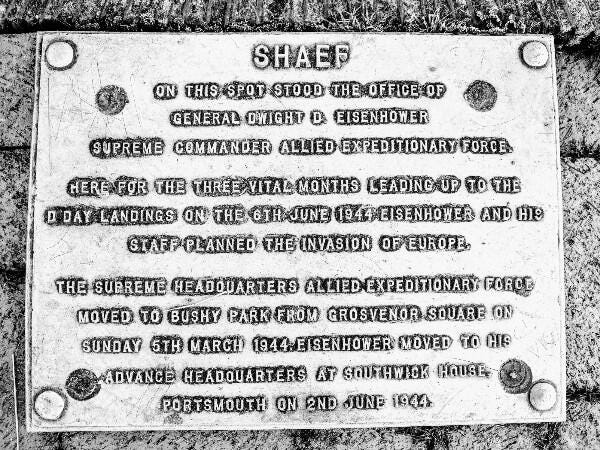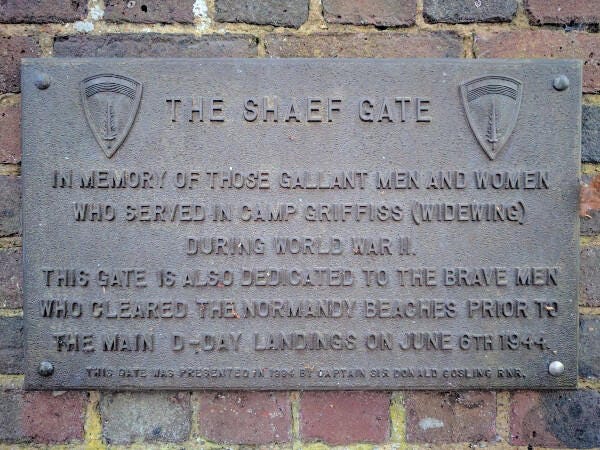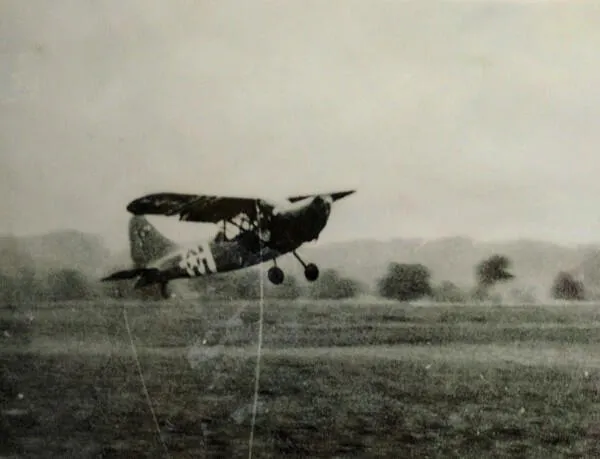BUSHY PARK’S VITAL ROLE IN WORLD WAR TWO

SUPPORT THE POPPY APPEAL
PHOTO FILE SPECIAL








The tranquil 1100 acres of parkland and the home to thousands of roaming deer, wild birds, avenues of age-old trees, ramblers, cyclists and dog walkers that we know and love as Bushy Park was turned into a vital military base in the Second World War playing an important role in the build-up and preparation for the D-Day landings in 1944 known as Operation Overlord.
It was an unlikely setting for war-planning with the stunning 17th century Diana Fountain bronze statue and surrounding lake designed by Sir Christopher Wren and just a stone’s throw from Hampton Court Palace, the famous Royal residence of Henry V111 – Bushy Park was often described as the back garden of the Palace.
But the US Air Force set up Camp Griffiss in Bushy Park in 1942, named after the first American airman killed in a friendly fire incident in Europe, Lieutenant Townsend Griffiss, aged 41, when the US entered first entered the war.
The massive camp had the codename ‘Widewing’ and the Park housed the Eighth Air Force, a US strategic bombing force with accommodation huts A, B, C and D, a small airstrip and equipped with air defences, radar detection and anti-craft weaponry.

It was set up deliberately away from central London to reduce the risk of air attacks but it was a common belief amongst those stationed at the camp that the US base was originally intended to be at Bushey in Hertfordshire and was built in Bushy Park due to an error.
In 1943 the legendary US General Dwight ‘Ike’ Eisenhower was based in Bushy Park rather than his stuffy office HQ in central London in Grosvenor Square and put in charge of planning the invasion of Europe from Camp Griffiss which became known as the Supreme Headquarters Allied Expeditionary Force or SHAEF – now commemorated in the naming of SHAEF WAY – a road near Sandy Lane, just outside the Park.
The SHAEF gate can still be seen where a plaque is dedicated to those who were based there. It says: “IN MEMORY OF THE THOSE GALLANT MEN AND WOMEN WHO SERVED IN CAMP GRIFFISS (WIDEWING) DURING WORLD WAR 11. THIS SITE IS ALSO DEDICATED TO THE BRAVE MEN WHO CLEARED THE NORMANDY BEACHES PRIOR TO THE MAIN D-DAY LANDINGS ON JUNE 6TH 1944.”
The Supreme Commander General Eisenhower, his deputy Air Chief Marshal Sir Arthur Tedder and Eisenhower’s chief of staff, General Walter Bedell Smith, were actually based at Bushy Park in the months prior to D-Day.
The detailed description below can be seen just inside Bushy Park’s SHAEF GATE with a artistic depiction of the historic role of Camp Griffiss. It says the following:
“General. Dwight D. Eisenhower was appointed Supreme Commander of the Allied Expeditionary Force in December 1943 – their task the liberation of Europe.
General Spaatz’s Eighth United States Army Air Force (U.S.A.A.F.) had been installed at Camp Griffiss, Bushy Park since September 1942.
The camp was named after Lt. Colonel Townsend Griffiss, the first U.S.A.A.F. officer to be killed in the European Theatre of Operation.
The building had been put up as emergency office accommodation after the destruction in London during the Blitz. These temporary structures were to form the nucleus of Camp Griffiss codenamed Widewing.
The site of Eisenhower’s office along with the remains of Camp Griffiss were demolished in the early 1960s when the Americans finally vacated the site
Eisenhower officially moved into C Block on March 5th 1944. The immense complex had 1600 US and 1299 British. The staff set up in ‘C’ Block along a dimly lit corridor. The concrete floors were bare, the offices cold and damp.
Eisenhower’s office covered only some 400 sq ft. his desk was square with three flags placed on it, his own four star general’s flag and those of the USA and Great Britain. There were two buzzers, one to call Kay Summersby while the other summoned his personal secretary Mattie Pinnette. He had two telephones on a table nearby, one of them his green ‘scrambler’ for secret conversations.
Around him hung pictures of his wife Mamie, his son, John and his mother Ida, together with signed photographs of Roosevelt, Cunningham and Marshall. The walls held secret maps which were locked behind a silver screen when non- commissioned personnel were present. A swivel chair, a couch and two armchairs completed the furnishings.
A reinstated floor and commemorative plaque have been constructed on the site of Eisenhowers’s office to mark the 50th Anniversary of the Normandy Landings. The sites of A, B, C and D Blocks have also been located in the grasslands and marked by plaques in the shape of open books.
Eisenhower and his Deputy Supreme Commander Air Marshal Tedder assembled around them the men who were to lead the fight.
Admiral Bertram Ramsey would command the Naval Forces.
General Montgomery was designated Commander of the Ground Forces.
Air Chief Marshall Leigh-Mallory took command of the newly-formed Allied Tactical Air Foce.
The plans and ideas of these men and their staffs, conceived in this quiet spot were destined to write the pages of history and to secure the future of the free world.”
It was an important site for a short time and although Eisenhower’s stay at the camp was brief, barely three months, no sooner had he moved in than plans were being made to set up both an advance and forward HQ at Portsmouth before the main HQ moved to France in September.
Anti-aircraft batteries were set up in the park and well-known landmarks like Diana Fountain, Leg of Mutton pond and Heron ponds were drained of water and covered with camouflage netting so as to not assist enemy bombers with navigation and bomb-sighting of the base. The water was later reinstated because of a fear of fires.


One of the most important functions of Bushy Park, according to historic records, was its association with the Special Operations Executive (SOE) conducting espionage and sabotage as well as being the HQ for the Radio Security Service where agents were trained in wireless operations and other forms of communication like coding and cryptography.
Bushy Park was also closely linked with Bletchley Park – the principal centre for WW11 codebreaking – and provided support for secure communication links and the transfer of intelligence.
Hundreds of women were amongst the troops with a wide range of duties ranging from radar and wireless operators, to drivers and administration roles and they were based in special quarters in the Millennium Wood near what is now Hampton Wick Royal Cricket Club.

The Park was an excellent base as the facilities could be well-disguised amidst the leafy park land and scenic boating lakes, all the while playing host to some of the most vital high level war-planning discussions, which proved so vital in the outcome of the war.
The famous General loved the serenity the Park environment offered but, according to historic documents, his staff missed the central London accommodation and nightlife and moaned about the cold, dark offices of Camp Griffiss. Ike himself enjoyed horse riding in Richmond Park and sketched views of Bushy Park from his office window.
For three months from Camp Griffiss, SHAEF staff took the overall Operation Overlord strategy and plotted the final plans which eventually saw over 150,000 allied troops storm the beaches of northern France on 6th of June 1944 to start the fight back across Nazi-occupied Europe.
At its height over 8000 US and British members of the military were house in Bushy Park.
SHAEF was relocated to Versailles in September 1944 but Camp Griffiss remained a military base until the 1960’s when the buildings including huts which lined Chestnut Avenue and several memorials and a flagpole remain in the Park including the distinctive plaque marking the spot of Eisenhower’s office.
The camp also required an airstrip for small aircraft to be constructed – which ran along a parallel line to the perimeter path where the playground is now located, near the main car park. Light aircraft were used as military ‘taxis’ to ferry senior officers on urgent business between bases.

The nearby Bushy House also contributed significant to the war effort with the creation of two important WWII inventions – the Spitfire and the Mulberry harbours, floating concrete pontoons that were towed across the Channel to create a temporary harbour and enabled large allied shops to offload supplies for the forces and the bouncing bomb was partly invented and tested by Barnes Wallis using the NPL’s ship-testing tanks.
For more information about the amazing Townsend Griffiss known as the ‘forgotten hero’’ go to: https://www.bbc.co.uk/news/magazine-17011105
(With special thanks to the Imperial War Museum, David Ivison, Friends of Bushy and Home Park and other sources. Any errors or inaccuracies are my responsibility)
IF YOU HAVE ANY RECOLLECTIONS OR PHOTOS OF WARTIME IN TEDDINGTON AND WOULD LIKE TO SHARE PLEASE GO TO CONTACT@TEDDINGTONTOWN.CO.UK
MORE SECRETS OF TEDDINGTON AT WAR COMING SOON


